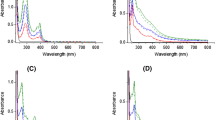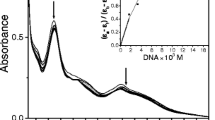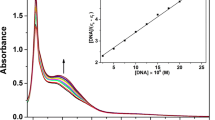Abstract
Three new complexes of the type [Ru(phen)2PIP-Cl](1) [Ru(bpy)2PIP-Cl](2) and [Ru(dmp)2PIP-Cl](3) (phen = 1,10-phenanthroline; bpy = 2,2′-bipyridine; dmb = 4,4-dimethyl-2,2′-bipyridine), PIP-Cl = 2-(4′-chloro-phenyl) imidazo[4,5-f][1,10]phenanthroline) were synthesized and characterized by using UV–VIS, IR and 1H-NMR, 13C-NMR spectral methods. Absorption spectroscopy, emission spectroscopy, viscosity measurements and DNA melting techniques were used to investigate the binding of these Ru(II) complexes with calf thymus DNA, and photocleavage studies were used to investigate the binding of these complexes with plasmid DNA. The spectroscopic studies together with viscosity measurements and DNA melting studies supported fact that Ru(II) complexes bind to CT-DNA(calf thymus DNA) by an intercalation mode via PIP-Cl into the base pairs of DNA. Upon irradiation, these novel Ru(II) complexes cleave the plasmid pBR 322 DNA from the supercoiled form I to the open circular form II.









Similar content being viewed by others
References
Arounaguiri S, Maiya BG (1996) Dipyridophenazine complexes of cobalt(III) and nickel(II): DNA-binding and photocleavage studies. Inorg Chem 35:4267–4270
Ashwini Kumar K, Kotha Laxma Reddy, Satyanarayana S (2010) Synthesis, DNA interaction and photocleavage studies of ruthenium(II) complexes with 2-(pyrrole) imidazo[4, 5-f]-1, 10-phenanthroline as an intercalative ligand. J Transition Met Chem 35:713–720
Barton JK, Raphael AL (1984) Photoactivated stereospecific cleavage of double-helical DNA by cobalt(III) complexes. J Am Chem Soc 106:2466–2468
Choi SD, Kim MS, Kim SK, Lincoln P, Tuite E, Norde′n B (1997) Binding Mode of [Ruthenium(II) (1, 10-Phenanthroline)2L]2+ with Poly(dT*dA-dT) Triplex. Ligand Size Effect on Third-Strand Stabilization. Biochemistry 36:214–223
Deng H, Cai JW, Xu H, Zhang H, Ji LN (2003) Ruthenium(II) complexes containing asymmetric ligands: synthesis, characterization, crystal structure and DNA-binding. J Chem Soc Dalton Trans 325-330
Devi CS, Nagababu P, Shilpa M, Yata PK, Reddy MR, Gabra NazarMd, Satyanarayana S (2012) Synthesis, characterization and DNA-binding characteristics of Ru(II) molecular light switch complexes. J Iran Chem Soc 9:671–680
Dupureur CM, Barton JK (1997) Structural studies of Λ- and Δ [Ru(phen)2dppz]2+ bound to d(GTCGAC)2: characterization of enantioselective intercalation. Inorg Chem 36:33–43
Graham DR, Marshall LE, Reich KA, Sigman DS (1980) Cleavage of DNA by coordination complexes. Superoxide formation in the oxidation of 1, 10-phenanthroline-cuprous complexes by oxygen - relevance to DNA-cleavage reaction. J Am Chem Soc 102:5419–5421
Haq I, Lincoln P, Suh D, Norden B, Chowdhry BZ, Chaires JB (1995) Interaction of.DELTA.- and LAMBDA.-[Ru(phen)2DPPZ]2+ with DNA: a calorimetric and equilibrium binding study. J Am Chem Soc 117:4788–4796
He X-F, Wang L, Chen H, Lin X, Ji L-N (1998) Synthesis, characterization and dna binding study of Co(III) polypyridyl mixed-ligand complexes. J Polyhdron 18:3161–3166
Hiort C, Lincoln P, Norde′n (1993) B DNA binding of DELTA and LAMBDA -[Ru(phen)2DPPZ]2+. J Am Chem Soc 115:3448–3454
Jenkins Y, Friedman AE, Turro NJ, Barton JK (1992) Characterization of dipyridophenazine complexes of ruthenium(II): the light switch effect as a function of nucleic acid sequence and conformation. Biochemistry 13:10809–10816
Jiang CW (2004) Homoleptic ruthenium (II) complexes containing asymmetric tridentate 2-(benzimidazole-2-yl)-1, 10-phenanthroline likes ligands: syntheses, characterization and DNA binding. J Inorg Biochem 98:1399–1404
Jiang CW, Chao H, Lang XL, Li H, Mei WJ, Ji LN (2003) Enantiopreferential DNA-binding of a novel dinuclear complex [(bpy)2Ru(bdptb)Ru(bpy)2]4+. Inorg Chem Commun 6:773–775
Kratochwil NA, Parkinson JA, Bednarski PJ, Salder PJ (1999) Nucleotide platination induced by visible light. Angew Chem Int Ed Engl 30:1460–1463
Lakowicz JR, Webber G (1973) Quenching of fluorescence by oxygen probe for structural fluctuations in macromolecules. Biochemistry 12:4161–4170
Lecomte JP, Kirsch-De Mesmaeker A, Kelly JM, Tosssi AB, Gorner H (1992) Photo induced electron transfer from mononucleotides to Ruthenium-tris-1,4,5,8-tetraazaphenanthrene: model for photosensitized DNA oxidation. Photochem Photobiol 55(5):681–689
Lincoln P, Norde′n B (1998) DNA binding geometries of ruthenium(II) complexes with 1, 10-phenanthroline and 2, 2′-bipyridyl ligands studied with linear dichroism spectra: borderline cases of intercalation. J Phys Chem B 102:9583
Lincoln P, Broo A, Norde′n B (1996) Diastereomeric DNA-binding geometries of intercalated ruthenium(II) trischelates probed by linear dichroism: [Ru(phen)2DPPZ]2+ and [Ru(phen)2BDPPZ]2+. J Am Chem Soc 118:2644–2653
Liu F, Wang K, Bai G, Zhang Y, Gao L (2004) The pH-induced emission switching and interesting DNA-binding properties of a novel dinuclear ruthenium(II) complex. Inorg Chem 43:1799–1806
Liu Y, Chouai A, Degtyareva NN, Lutterman DA, Dunbar KR, Turro C (2005) Chemical control of the DNA light switch: cycling the switch ON and OFF. J Am Chem Soc 127:10796
Marmur JA (1961) Procedure for the isolation of DNA from microorganisms. J Mol Biol 3:208–218
Morgan RJ, Chatterjee S, Baker AB, Strekas TC (1991) Effects of ligand planarity and peripheral charge on intercalative binding of Ru(2, 2′-bipyridine)2L2+ to calf thymus DNA. Inorg Chem 30:2687–2691
Moucheron C, Mesmaeker AKD, Choua C (1997) Photophysics of Ru(phen)2(PHEHAT)2+: a novel “Light Switch” for DNA and photo-oxidant for mononucleotides. Inorg Chem 36:584–592
Mudasir, Wijaya K, Wahyuni ET, Yoshioka N, Inoue H (2006) Salt-dependent binding of iron(II) mixed-ligand complexes containing 1, 10-phenanthroline and dipyrido[3, 2-a:2′, 3′-c]phenazine to calf thymus DNA. Biophys Chem 121:44–50
Nagababu P, Shilpa M, Latha JNL, Bhatnagar I, Srinivas PNBS, Yata PK, Reddy KL, Satyanarayana S (2011) Synthesis, characterization, DNA binding properties, fluorescence studies and toxic activity of cobalt(III) and ruthenium(II) polypyridyl complexes. J Fluores 21:563–572
Perrin D, Annarego WLF, Perrin DR (1980) Purification of laboratory chemicals, 2nd edn. Pergamon, New York
Pyle, A.M, Barton JK, Lippard S.J (1990) Progress in inorganic chemistry bio inorganic chemistry. (ed), John Wiley & Sons, New York. 38: 413-475
Pyle AM, Rehmann JP, Meshoyrer R, Kumar CV, Turro NJ, Barton JK (1989) Mixed-ligand complexes of ruthenium(ii): factors governing binding to DNA. J Am Chem Soc 111:3053
Record MT Jr, Anderson CF, Lohman TM (1978) Thermodynamic analysis of ion effects on the binding and conformational equilibria of proteins and nucleic acids: the roles of ion association or release, screening, and ion effects on water activity. Q Rev Biophys 11:103–178
Rreichmann ME, Rice SA, Thomas CA, Doty P (1954) A further examination of the molecular weight and size of desoxypentose nucleic acid. J Am Chem Soc 76:3047–3053
Satyanarayana S, Dabrowiak JC, Chaires JB (1992) Neither Δ- nor Λ tris(phenanthroline(ruthenium)(II) binds to DNA by classical intercalation. Biochemistry 31:9319–9324
Satyanarayana S, Dabrowiak JC, Chaires JB (1993) Tris (phenanthroline) ruthenium(II) enantiomer interactions with DNA: mode and specificity of binding. Biochemistry 32:2573–2584
Shilpa M, Latha JNL, Gayatri Devi A, Nagarjuna A, Kumar YP, Nagababu P, Satyanarayana S (2011) DNA–interactions of ruthenium(II) & cobalt(III) phenanthroline and bipyridine complexes with a planar aromatic ligand 2-(2-fluronyl)1H-imidazo[4,5-f][1,10-Phenanthroline]. J Incl Phenom Macrocycl Chem 70:187–195
Tan LF, Chao H, Li H, Liu YJ, Sun B, Wei W, LN Ji (2005) Synthesis, characterization, DNA-binding and photocleavage studies of [Ru(bpy)2(PPIP)]2+ and [Ru(phen)2(PPIP)]2+. J inorg Biochem 99:513–520
Wolfe A, Shimer GH, Meehan T Jr (1987) Polycyclic aromatic hydrocarbons physically intercalate into duplex regions of denatured DNA. Biochemistry 26:6392–6396
Xiong Y, Ji LN (1999) Synthesis, DNA-binding and DNA-mediated luminescence quenching of Ru(II) polypyridine complexes. Coord Chem 185:711–733
Xiong Y, He XF, Zou XH, Wu JZ, Chen XM, Ji RH, Li JY, Zhou KB, (1999) Interaction of polypyridyl ruthenium(II) complexes containing non-planar ligands with DNA. J Chem SOC Dalton Trans 1:19-24
Yata PK, Shilpa M, Nagababu P, Reddy MR, Reddy KL, Gabra NazarMd, Satyanarayana S (2012) Study of DNA light switch Ru(II) complexes : synthesis, characterization, photocleavage and antimicrobial activity. J Fluoresc 22:835–847
Zhen QX, Ye BH, Zang QL, Liu JG, Li H, Ji LN, Wang L (1999) Synthesis, characterization and the effect of ligand planarity of [Ru(bpy)2L]2+ on DNA binding affinity. J Inorg Biochem 76:47–53
Zou XH, Ye BH, Li HJ, Liu G, Xiong Y, Ji LN (1999) Mono- and bi-nuclear ruthenium(II) complexes containing a new asymmetric ligand 3-(pyrazin-2-yl)-as-triazino[5,6-f ]1,10-phenanthroline: synthesis, characterization and DNA-binding properties. J Chem Soc Dalton Trans 1423–1428
Acknowledgments
We are grateful to the Indian Council for Cultural Relations (ICCR), Hyderabad, for financial support.
Author information
Authors and Affiliations
Corresponding author
Rights and permissions
About this article
Cite this article
Gabra, N.M., Mustafa, B., Kumar, Y.P. et al. DNA-binding and cleavage, cytotoxicity properties of Ru(II) complexes with 2-(4′-chloro-phenyl) imidazo[4,5-f][1,10]phenanthroline, ligand and their “light switch” on–off effect. Med Chem Res 23, 224–235 (2014). https://doi.org/10.1007/s00044-013-0617-1
Received:
Accepted:
Published:
Issue Date:
DOI: https://doi.org/10.1007/s00044-013-0617-1




